
mindcontrolinamerica.com

Hypnosis and "Reefer Madness"
From the book
Mind Control in America
by Steven Jacobson
Chapter 6. Hypnosis and "Reefer Madness"
pp.11-14.
The power of hypnosis
is the power of suggestion.
The power of suggestion is the power of belief. It is
an act of faith. The conscious mind cannot be
controlled by the suggestions of someone else when
those suggestions are contrary to what you know
from your own experience. But the subconscious
mind is susceptible to control by suggestion. (35)
The subconscious mind has absolute control of the
functions, conditions, and sensations of the
body.
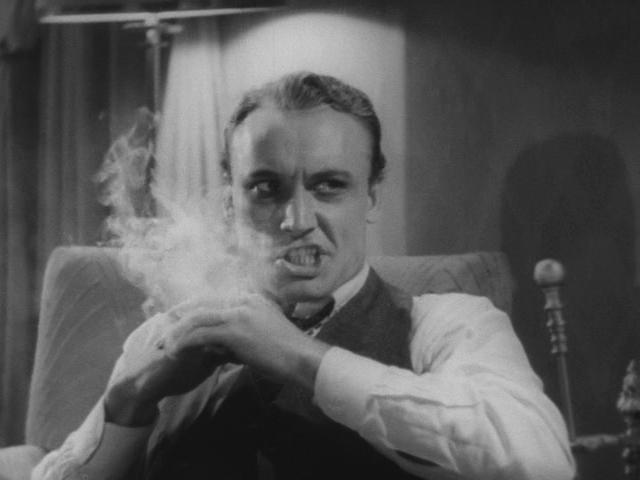 Perfect anesthesia can be produced by
suggestion. Hundreds of cases are recorded where
surgical operations have been performed without
pain to patients under hypnosis. Symptoms of
almost any disease can be induced in hypnotic
subjects by suggestions. Partial or total paralysis
can be produced; fever can be brought on, with all
the attendant symptoms such as rapid pulse and
high temperature. (36)
Perfect anesthesia can be produced by
suggestion. Hundreds of cases are recorded where
surgical operations have been performed without
pain to patients under hypnosis. Symptoms of
almost any disease can be induced in hypnotic
subjects by suggestions. Partial or total paralysis
can be produced; fever can be brought on, with all
the attendant symptoms such as rapid pulse and
high temperature. (36)
In 1936, a movie used hypnotic suggestion to give
the audience instructions to do something. That
movie was
"Reefer Madness."
Shown widely on college campuses and at midnight screenings
across the country since 1972, "Reefer Madness"
uses sophisticated hypnotic techniques to both
encourage marijuana use and promote
 anti-marijuana use and promote anti-marijuana
legislation.
anti-marijuana use and promote anti-marijuana
legislation.
 Speaking to a PTA meeting, high school
principal Dr. Carroll commands parents to
stamp out this "assassin of our
youth"--marijuana. When Dr. Carroll begins to
speak, he raises a sheet of paper in front of him
and reads certain "facts" from it.
Speaking to a PTA meeting, high school
principal Dr. Carroll commands parents to
stamp out this "assassin of our
youth"--marijuana. When Dr. Carroll begins to
speak, he raises a sheet of paper in front of him
and reads certain "facts" from it.
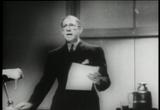 The white sheet of paper prominent in the middle of the
screen is a distraction for the eyes to cause
that state of mind that is just like "day dreaming" while
information is programmed to the audience
verbally. Dr. James Braid discovered that by
placing a bright object before the eyes of the
subject, and causing him to gaze upon it with
persistent attention, he could be led into the
hynotic state of mind. (37)
The white sheet of paper prominent in the middle of the
screen is a distraction for the eyes to cause
that state of mind that is just like "day dreaming" while
information is programmed to the audience
verbally. Dr. James Braid discovered that by
placing a bright object before the eyes of the
subject, and causing him to gaze upon it with
persistent attention, he could be led into the
hynotic state of mind. (37)
Dr. Carroll delivers his lines with a hypnotic
rhythm that is punctuated by changes in
pacing, volume and tone (just like a hypnotist).
Dr. Carroll speaks with authority. This happens
to be a technique used in hypnosis.
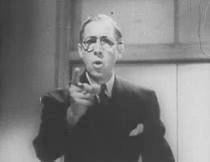
|
''
What are the common mechanisms of these and dozens
of other variations of hypnotising methods?
1. A prestigious (verging on authoritarian) hypnotist
capable of modulating his/her voice and behaviour...
''
(Georgi Lozanov, Suggestopaedia,
The Journal of the Society for Accelerative Learning and
Teaching, volume 3, issue 3, Fall, 1978, p.211)
[link]
|
Authoritarian techniques, sometimes called
paternal techniques, use a strong,
commanding, dominating approach. (38) Dr.
Carroll looks into the camera and into the eyes
of the audience--another hypnotic technique.
Picture yourself in a movie theatre, now
imagine a huge face on the screen staring at
you.
Other hypnotic techniques used in "Reefer Madness" include
|
|

|
A short flash found near the close of "Reefer Madness,"
when prosecutor, defense attorney, and judge all agree
that defendant Ralph Wiley is, "hopelessly and incurably insane,
a condition caused by the drug marijuana to which he is addicted."
In some versions of the movie this crazy eye scene is missing.
[gif animation]
[video of this sequence]
(below)
Reefer Madness contains one scene with a swinging hypnotic pendulum.
A cord for a lamp swings as the jury deliberates Bill Harper's fate.
A subsequent closeup of the pendulous cord handle fades into a
swinging hangman's noose.
[mpg video of this sequence, 2.7M]
|
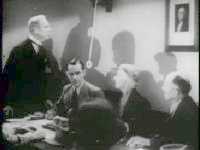
|
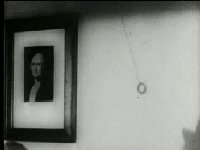
|

|
two-frame flashes
in different places in the movie. These flash
frames produce a corresponding wave in the
brain. These flash frames "anchor" information
from the sound track to your mind. These flash
frames add emphasis to information on the
sound track, making that information more
important.
Dr. Carroll slams his fist on the desk frequently
to emphasize a point.
This sudden burst of sound "anchors"
information to your mind. The added sound
cue makes the information important.
There is even a scene with a swinging hypnotic pendulum!
The stated intent of Reefer Madness "was to
stamp out the menace of marijuana because it
leads to "acts of shocking violence, ending
often in incurable insanity."
In contrast, young people are shown having a good time smoking
marijuana, partying, dancing, kissing and
retreating to the bedroom.
By showing young people having a good time smoking marijuana,
Reefer Madness encourages young people to
at least try it. By confusing
marijuana with heroin and by telling the story
of normal kids going berserk because of
marijuana,
"Reefer Madness" scares older
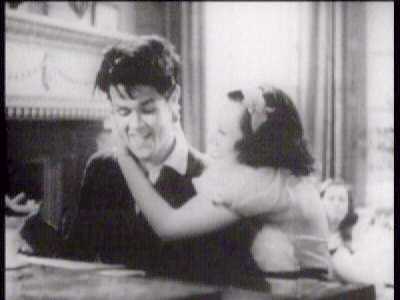 people into demanding that something be done.
people into demanding that something be done.
Why are there conflicting messages in the
movie?
Why was hypnosis used in this movie and with
such a high level of sophistication? The
answers are within the movie.
"You government men have got to find some
way to put an end to it," demands Dr. Carroll.
 The government man replies: "Of course, I
agree with you Dr. Carroll. But do you realize
that marihuana is not like other forms of DOPE.
You see, it grows wild in almost every state of
the union.
The government man replies: "Of course, I
agree with you Dr. Carroll. But do you realize
that marihuana is not like other forms of DOPE.
You see, it grows wild in almost every state of
the union.
Therefore, there is practically no inter-state
commerce in the drug. As a result, the government's
hands are tied. And frankly, the only sure cure is a
wide-spread campaign in education." Some words
trigger strong emotional responses in people. The
word
DOPE
is one of them. This word is
emphasized on the sound track. Though we are told
that marijuana is not like other forms of "dope," the
association is established.
Harry Anslinger was the first U.S. Commissioner of
Narcotics, a position he held for 32 years; and was
U.S. Representative on the United Nations
Commission on Narcotic Drugs. In his book "The Murderers,"
 he wrote about his campaign against
marijuana: "By 1937, under my direction, the bureau
launched two important steps: first, a legislative plan
to seek from Congress a new law that would place
marihuana and its distribution directly
under federal control. Secondly, on radio and at
major forums...I told of this evil weed of the fields
and riverbeds and roadsides. I wrote articles for
magazines; our agents gave hundreds of lectures to
parents, educators, social and civic leaders. In
network broadcasts I reported on the growing list of
crime, including murder and rape."
he wrote about his campaign against
marijuana: "By 1937, under my direction, the bureau
launched two important steps: first, a legislative plan
to seek from Congress a new law that would place
marihuana and its distribution directly
under federal control. Secondly, on radio and at
major forums...I told of this evil weed of the fields
and riverbeds and roadsides. I wrote articles for
magazines; our agents gave hundreds of lectures to
parents, educators, social and civic leaders. In
network broadcasts I reported on the growing list of
crime, including murder and rape."
One of the articles Harry Anslinger wrote appeared
in the July 1937 issue of "The American Magazine"
titled "Marihuana--Assassin of Youth."
There are striking similarities between the content of this article and
the content of the movie Reefer Madness.
For example, from the article: "In 1931,
the marijuana file of the United States Narcotic
Bureau was less than two inches thick, while today
 the reports crowd many large cabinets." Now
compare this to what appeared in the movie. Dr.
Carroll is with the government man who says:
"Let me show you something. In 1930,
the records on marijuana in the Washington office of the Narcotics
Division scarcely filled a small folder like this (less
than two inches thick). Today, they fill cabinets." The
camera shows us a wall lined with file cabinets.
the reports crowd many large cabinets." Now
compare this to what appeared in the movie. Dr.
Carroll is with the government man who says:
"Let me show you something. In 1930,
the records on marijuana in the Washington office of the Narcotics
Division scarcely filled a small folder like this (less
than two inches thick). Today, they fill cabinets." The
camera shows us a wall lined with file cabinets.

In the book "Outsiders," Howard S. Becker
describes how the Federal Bureau of Narcotics
under Harry Anslinger created the marijuana
problem to cause the public to demand
legislation. (39)
A bill giving the federal government control
over marijuana was introduced in Congress by
representative Robert L. Doughton of North
Carolina, Chairman of the House Ways and
Means Committee. (40) On August 2, 1937,
Franklin Delano Roosevelt signed into law the
Marijuana Tax Act,
which became effective on October 1, 1937. (41)
The purpose of propaganda is to
direct public attention to certain "facts."
 "The whole art consists in doing this so
skillfully that everyone will be convinced that
the fact is real," writes Adolf Hitler in "Mein Kampf."
He describes the principles of
effective propaganda: it must repeat those
points over and over again until the public
believes it. To be effective, propaganda must
constantly short-circuit all thought and
decision. It must operate on the individual
subconsciously. (42) The principles behind
"The Big Lie" of propaganda
are the same principles of mind control, hypnotic
suggestion, mental programming: distraction
and repetition. With propaganda, distraction
draws attention away from information that is
true and directs attention to information that is
false. Repetition of the false information
imbeds it in your subconscious mind so that
your
acceptance of its truth becomes a conditioned
response. You accept this information as true
without thinking whenever it is presented to
you again.
"The whole art consists in doing this so
skillfully that everyone will be convinced that
the fact is real," writes Adolf Hitler in "Mein Kampf."
He describes the principles of
effective propaganda: it must repeat those
points over and over again until the public
believes it. To be effective, propaganda must
constantly short-circuit all thought and
decision. It must operate on the individual
subconsciously. (42) The principles behind
"The Big Lie" of propaganda
are the same principles of mind control, hypnotic
suggestion, mental programming: distraction
and repetition. With propaganda, distraction
draws attention away from information that is
true and directs attention to information that is
false. Repetition of the false information
imbeds it in your subconscious mind so that
your
acceptance of its truth becomes a conditioned
response. You accept this information as true
without thinking whenever it is presented to
you again.
 There is a vast amount of misinformation about
marijuana, much of it originating in the 1930's
with the so-called "educational campaign," of
the Federal Bureau of Narcotics.
Propaganda
is not only meant to influence opinions and
attitudes but also to cause action. Government
propaganda 'suggests' that public opinion
demands what the government has already
decided to do. (43) The official reasons given
by the Federal Bureau of Narcotics for its
opposition to the use of marijuana shifted
completely during 1949-1950 from the claim
that use of marijuana led to crime and violence
to the claim that marijuana use led to heroin
use. (44) When questioned by Congressman
John Dingell of Michigan during testimony
before the House Ways and Means Committee
whether "the marijuana addict graduates into a
heroin, an opium, or a cocaine user,"
Commissioner Anslinger replied: "No, Sir; I
have not heard of a case of that kind." (45)
There is a vast amount of misinformation about
marijuana, much of it originating in the 1930's
with the so-called "educational campaign," of
the Federal Bureau of Narcotics.
Propaganda
is not only meant to influence opinions and
attitudes but also to cause action. Government
propaganda 'suggests' that public opinion
demands what the government has already
decided to do. (43) The official reasons given
by the Federal Bureau of Narcotics for its
opposition to the use of marijuana shifted
completely during 1949-1950 from the claim
that use of marijuana led to crime and violence
to the claim that marijuana use led to heroin
use. (44) When questioned by Congressman
John Dingell of Michigan during testimony
before the House Ways and Means Committee
whether "the marijuana addict graduates into a
heroin, an opium, or a cocaine user,"
Commissioner Anslinger replied: "No, Sir; I
have not heard of a case of that kind." (45)
However, in 1955, Anslinger appeared before a
Senate subcommittee investigating the traffic
in illicit drugs and testified that marijuana leads
to heroin addiction. (46)
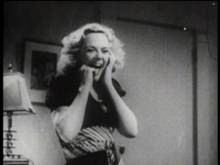
During
Congressional hearings in 1937,
Dr. C. W. Woodward, Legislative Counsel for the
American Medical Association, pointed out that
there was no competent primary evidence to
support the claims against marijuana, only
newspaper accounts about growing marijuana
addiction and that marijuana causes crime.
(47).
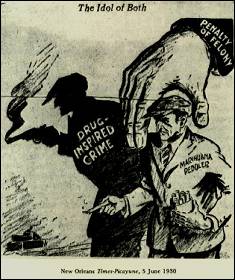 These "news" accounts were "planted" by the
Federal Bureau of Narcotics. Of seventeen
articles condemning marijuana that appeared
in popular magazines from July 1937 to June
1939, ten either acknowledged the help of the
Bureau in furnishing facts and figures or gave
evidence of having received help by using
facts and figures that had appeared in Bureau
publications or in testimony given during
Congressional hearings. An indication of the
These "news" accounts were "planted" by the
Federal Bureau of Narcotics. Of seventeen
articles condemning marijuana that appeared
in popular magazines from July 1937 to June
1939, ten either acknowledged the help of the
Bureau in furnishing facts and figures or gave
evidence of having received help by using
facts and figures that had appeared in Bureau
publications or in testimony given during
Congressional hearings. An indication of the
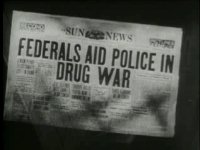 people into demanding that something be done.
people into demanding that something be done.
Bureau's influence in these articles is found in
repeated "atrocity" stories that were first
reported by the Bureau. (48) These same
stories appeared in "Reefer Madness."
|







 Perfect anesthesia can be produced by
suggestion. Hundreds of cases are recorded where
surgical operations have been performed without
pain to patients under hypnosis. Symptoms of
almost any disease can be induced in hypnotic
subjects by suggestions. Partial or total paralysis
can be produced; fever can be brought on, with all
the attendant symptoms such as rapid pulse and
high temperature. (36)
Perfect anesthesia can be produced by
suggestion. Hundreds of cases are recorded where
surgical operations have been performed without
pain to patients under hypnosis. Symptoms of
almost any disease can be induced in hypnotic
subjects by suggestions. Partial or total paralysis
can be produced; fever can be brought on, with all
the attendant symptoms such as rapid pulse and
high temperature. (36)
 anti-marijuana use and promote anti-marijuana
legislation.
anti-marijuana use and promote anti-marijuana
legislation.
 The white sheet of paper prominent in the middle of the
screen is a distraction for the eyes to cause
that state of mind that is just like "day dreaming" while
information is programmed to the audience
verbally. Dr. James Braid discovered that by
placing a bright object before the eyes of the
subject, and causing him to gaze upon it with
persistent attention, he could be led into the
hynotic state of mind. (37)
The white sheet of paper prominent in the middle of the
screen is a distraction for the eyes to cause
that state of mind that is just like "day dreaming" while
information is programmed to the audience
verbally. Dr. James Braid discovered that by
placing a bright object before the eyes of the
subject, and causing him to gaze upon it with
persistent attention, he could be led into the
hynotic state of mind. (37)





 people into demanding that something be done.
people into demanding that something be done.
 he wrote about his campaign against
marijuana: "By 1937, under my direction, the bureau
launched two important steps: first, a legislative plan
to seek from Congress a new law that would place
marihuana and its distribution directly
under federal control. Secondly, on radio and at
major forums...I told of this evil weed of the fields
and riverbeds and roadsides. I wrote articles for
magazines; our agents gave hundreds of lectures to
parents, educators, social and civic leaders. In
network broadcasts I reported on the growing list of
crime, including murder and rape."
he wrote about his campaign against
marijuana: "By 1937, under my direction, the bureau
launched two important steps: first, a legislative plan
to seek from Congress a new law that would place
marihuana and its distribution directly
under federal control. Secondly, on radio and at
major forums...I told of this evil weed of the fields
and riverbeds and roadsides. I wrote articles for
magazines; our agents gave hundreds of lectures to
parents, educators, social and civic leaders. In
network broadcasts I reported on the growing list of
crime, including murder and rape."
 the reports crowd many large cabinets." Now
compare this to what appeared in the movie. Dr.
Carroll is with the government man who says:
"Let me show you something. In 1930,
the records on marijuana in the Washington office of the Narcotics
Division scarcely filled a small folder like this (less
than two inches thick). Today, they fill cabinets." The
camera shows us a wall lined with file cabinets.
the reports crowd many large cabinets." Now
compare this to what appeared in the movie. Dr.
Carroll is with the government man who says:
"Let me show you something. In 1930,
the records on marijuana in the Washington office of the Narcotics
Division scarcely filled a small folder like this (less
than two inches thick). Today, they fill cabinets." The
camera shows us a wall lined with file cabinets.


 There is a vast amount of misinformation about
marijuana, much of it originating in the 1930's
with the so-called "educational campaign," of
the Federal Bureau of Narcotics.
There is a vast amount of misinformation about
marijuana, much of it originating in the 1930's
with the so-called "educational campaign," of
the Federal Bureau of Narcotics.




